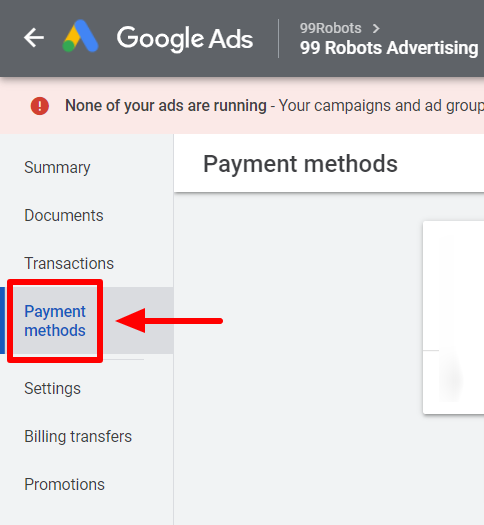In today's digital landscape, as you embark on your journey into the realm of Google Ads, understanding the various payment methods is crucial. This blog will delve into the essential aspects you need to know about Google Ads payment methods, helping you make informed decisions to effectively manage your advertising budget.

Payment options
Google Ads offers multiple payment options to cater to diverse business needs. The two primary payment methods are automatic payments and manual payments.
Automatic payments
Automatic payments offer a convenient choice for advertisers aiming to streamline their process and prevent interruptions due to insufficient funds. When you opt for automatic payments, Google Ads will automatically charge you once your ads have accumulated costs. You can even set a specific threshold for when you want the charges to occur. This way, you can ensure a steady balance to keep your ads running smoothly.
One of the primary advantages of automatic payments is the time-saving aspect. You're spared the need to manually add funds, allowing you to concentrate on refining your advertising strategy. Furthermore, automatic payments guarantee continuous ad display without any breaks, ensuring a consistent online presence.
Manual payments
Manual payments are a great choice for businesses working with a limited budget or aiming for tighter control over their ad expenses. With this method, you add funds to your account before launching your ads, enabling you to establish a specific campaign budget and avoid overspending. Moreover, manual payments offer flexibility in payment methods, encompassing credit and debit cards, bank transfers, and localized payment options.
A notable advantage of manual payments lies in the ability to closely monitor your ad expenditures. This lets you track your spending on advertising efforts and fine-tune your budget accordingly. Additionally, this payment approach suits businesses seeking to evaluate their ad effectiveness before committing to a larger budget.
Monthly invoicing
Monthly invoicing benefits businesses with substantial billing cycles, providing credit for ads and a consolidated end-of-month invoice with a set payment due date. This requires meeting Google's eligibility criteria.
Monthly invoicing offers flexibility in managing ad budgets, allowing ad operations without frequent fund additions and providing extra time for cost settlement. Additionally, it aids in cash flow management.
In conclusion, understanding Google Ads' payment options is vital for budget optimization. Choose from manual, automatic, or monthly invoicing methods based on your business needs for effective ad campaigns and marketing success.
Factors to choose a payment method
Billing cycles
Understanding the billing cycle is crucial to managing your advertising budget effectively. Google Ads operates on a monthly billing cycle, starting on the day you create your account. Your billing cycle encompasses the accrual of costs and payment transactions. Keeping track of your billing cycle helps you stay on top of your ad spend and make timely adjustments if needed.
Billing thresholds
For accounts using automatic payments, Google Ads sets a billing threshold based on your average daily spending. This threshold is the point at which your account is charged. Once your account reaches the billing threshold or the end of the billing cycle, whichever comes first, Google charges your payment method. It's essential to monitor your account's progress toward the billing threshold to avoid unexpected charges.
Payment methods
Google Ads supports a range of payment methods, including credit and debit cards, bank transfers, and direct debit. Choose a payment method that aligns with your financial preferences and convenience. Ensure that your chosen payment method is accepted and authorized for online transactions.
Currency and conversion
If you're advertising in a currency other than your local currency, Google Ads will convert your costs into your local currency using the prevailing exchange rate. This conversion might impact the actual amount you're billed, so it's important to be aware of potential currency fluctuations.
Taxes and charges
In India, advertisers are subject to an 18% Goods and Services Tax (GST) on top of their ad spend. This tax is automatically applied to your advertising costs. Understanding the tax implications is essential to accurately budgeting for your Google Ads campaigns.
Setting budgets
Setting a clear and realistic budget is fundamental to a successful Google Ads campaign. It's essential to align your budget with your advertising goals and business objectives. You can set a daily budget for each campaign, ensuring that your spending remains within your desired limits.
Monitoring and reporting
Regularly monitoring your Google Ads account is crucial to ensure your campaigns are performing as expected. Use the reporting tools provided by Google Ads to track the effectiveness of your ads, keywords, and overall campaign. Adjust your budget and bidding strategies based on the performance data to optimize your results.
Conversion tracking
Conversion tracking allows you to measure the success of your campaigns by monitoring the actions users take after clicking on your ads. Setting up conversion tracking helps you understand which keywords and ads are driving valuable actions, enabling you to allocate your budget more effectively.
Conclusion
Navigating the world of Google Ads payment methods requires a solid understanding of the options available and how they align with your business goals. Choosing the right payment method, setting appropriate budgets, and regularly monitoring your campaigns are essential steps to maximize your advertising investment. By staying informed and making data-driven decisions, you can harness the power of Google Ads to drive targeted traffic and achieve your marketing objectives.
The content of the article is referenced from an article by Mega Digital - Google Partner and TikTok Advertising Agency.
Follow their social channel to read more interesting articles about online advertising: https://www.linkedin.com/company/megadigital-jsc/

No comments yet